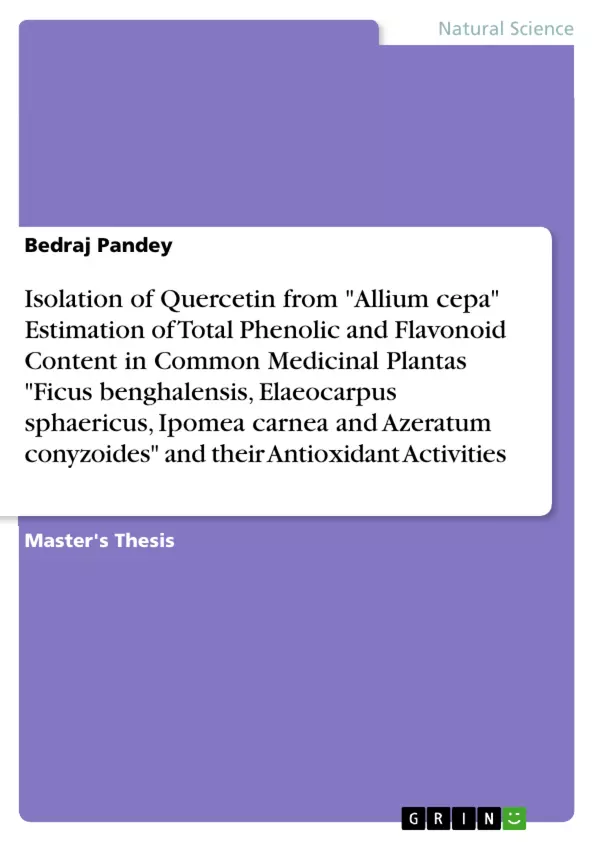Quercetin, a flavonol was isolated from the ethyl acetate soluble portion of the methanol extract of outer scale of onion (Allium cepa Linnaeus) by repeated sephadex LH-20 column chromatography. The isolated quercetin was characterized by comparing melting point, Rf values, UV and IR spectra with authentic quercetin. Recently, attention has focused on phytochemicals as new sources of natural antioxidants. Therefore, the methanol extracts, 50% aqueous methanol extracts and 70% aqueous acetone extracts of different parts of four medicinal plants Ficus benghalensis, Elaeocarpus sphaericus, Ipomea carnea and Azeratum conyzoides from Kirtipur, Kathmandu, Nepal were screened for total phenolic content, total flavonoid content and free radical scavenging activity. Total phenolic content was measured spectrophotometrically by using Folin-Ciocalteu reagent and total flavonoid content by using aluminum chloride colorimetric method. Gallic acid was used as the standard for the calibration of phenolics and quercetin for flavonoids. Free radical scavenging activity was evaluated using 2,2-diphenyl-1-picryl-hydrazyl (DPPH) assay. All investigated medicinal plant extracts contain high amount of phenolic but the highest amount of phenolic was detected in 70% aqueous acetone extract of Elaeocarpus sphericus (298.769±9.034 mg GAE/g) and lowest amount in 50% aqueous methanol extract of Ficus benghalensis (6.730±0.737 mg GAE/g). The highest amount of flavonoid was found in methanol extract (78.188±2.719 mg quercetin/g) of Ficus benghalens and the lowest amount was detected in 50% aqueous methanol extract (2.125±0.250 mg quercetin/g) of Ficus benghalenss. DPPH assay was carried out only for 70% acetone extracts of medicinal plants, IC50 value was calculated and correlated with total phenolic contents. A strong linear correlation between total phenolic content and antioxidant activity was found (correlation coefficient, R2 = 0.931), indicating that the major antioxidant compounds are phenolic.
Inhaltsverzeichnis (Table of Contents)
- Chapter 1: Introduction
- 1.1: Background
- 1.2: Literature Review
- 1.3: Statement of the Problem
- 1.4: Objectives of the Study
- 1.5: Significance of the Study
- Chapter 2: Materials and Methods
- 2.1: Collection of Plant Materials
- 2.2: Preparation of Plant Extracts
- 2.3: Isolation of Quercetin from Allium cepa
- 2.4: Quantification of Total Phenolic Content
- 2.5: Quantification of Total Flavonoid Content
- 2.6: Antioxidant Activities of the Extracts
- 2.6.1: DPPH Radical Scavenging Activity
- 2.6.2: Reducing Power Assay
- Chapter 3: Results and Discussion
- 3.1: Isolation and Characterization of Quercetin from Allium cepa
- 3.2: Estimation of Total Phenolic and Flavonoid Content
- 3.3: Antioxidant Activity of the Extracts
- Chapter 4: Conclusion
- References
Zielsetzung und Themenschwerpunkte (Objectives and Key Themes)
This dissertation aims to isolate quercetin from Allium cepa (onion) and to evaluate the total phenolic and flavonoid content, as well as the antioxidant activities of four common medicinal plants: Ficus benghalensis, Elaeocarpus sphaericus, Ipomea carnea, and Azaratum conyzoides.
- Isolation and characterization of quercetin from onion
- Quantification of total phenolic and flavonoid content in medicinal plants
- Evaluation of antioxidant activities of plant extracts
- Determination of the potential of these medicinal plants as sources of natural antioxidants
- Contribution to the understanding of the phytochemical composition and biological properties of these plants
Zusammenfassung der Kapitel (Chapter Summaries)
Chapter 1 provides a comprehensive overview of the research topic, including the background of quercetin and its health benefits, a review of relevant literature, and the specific objectives and significance of the study. Chapter 2 outlines the materials and methods used in the study, including the collection and preparation of plant materials, the isolation of quercetin from onion, the quantification of total phenolic and flavonoid content, and the evaluation of antioxidant activities using various assays. Chapter 3 presents the results and discussion, focusing on the characterization of isolated quercetin, the determination of phenolic and flavonoid content, and the analysis of antioxidant activities. The chapter also provides a detailed interpretation of the results in relation to previous research and the potential applications of the studied plants.
Schlüsselwörter (Keywords)
Quercetin, Allium cepa, Ficus benghalensis, Elaeocarpus sphaericus, Ipomea carnea, Azeratum conyzoides, medicinal plants, phenolic compounds, flavonoids, antioxidant activity, DPPH radical scavenging activity, reducing power assay.
- Quote paper
- Bedraj Pandey (Author), 2013, Isolation of Quercetin from "Allium cepa" Estimation of Total Phenolic and Flavonoid Content in Common Medicinal Plantas "Ficus benghalensis, Elaeocarpus sphaericus, Ipomea carnea and Azeratum conyzoides" and their Antioxidant Activities, Munich, GRIN Verlag, https://www.grin.com/document/412710



